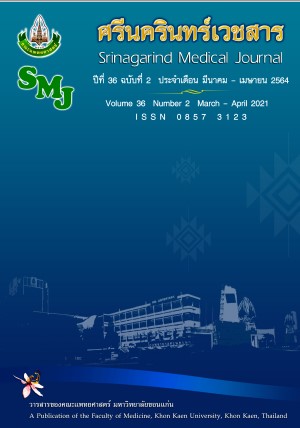ความหนาของผนังทรวงอกในบริเวณที่ใช้ในการใส่สายระบายทรวงอก
Abstract
หลักการและวัตถุประสงค์: การใส่สายระบายช่องอกในปัจจุบันกระทำในตำแหน่งที่เรียกว่า “Safe triangle” (ซึ่งประกอบด้วย ขอบด้านหน้าของกล้ามเนื้อ latissimus dorsi, ขอบหลังของกล้ามเนื้อ pectoralis major, และระดับของหัวนม) ผนังทรวงอกที่หนาขึ้นจะส่งผลต่อความยากของการทำหัตถการ การศึกษานี้จึงกระทำเพื่อให้ทราบถึงตำแหน่งที่ปลอดภัยสำหรับการใส่สายระบายช่องอก
วิธีการศึกษา: การศึกษาโดยร่างอาจารย์ใหญ่ ซึ่งใช้วิธีวัดความหนาของผนังช่องอกเพื่อให้ทราบถึงตำแหน่งที่บางที่สุด โดยกระทำการวัดในหน่วยมิลลิเมตรและวัดระดับดัชนีมวลกายร่วมด้วย
ผลการศึกษา: ทำการศึกษาร่างอาจารย์ใหญ่ 20 ร่าง ค่าเฉลี่ยความหนาของผนังทรวงอกในตำแหน่ง safe triangle อยู่ที่ 14.4 – 23.9 มิลลิเมตร ส่วนบริเวณที่มีความหนามากกว่า 50 มิลลิเมตรนั้นอยู่ที่ขอบหน้า axillary line (54 และ 56 มิลลิเมตร) ตัดกับช่องซี่โครงช่องที่ 3 ในขณะที่บริเวณที่บางที่สุด (14.4 มิลลิเมตร) อยู่บริเวณซี่โครงช่องที่ 7 และเพศหญิงมักมีผนังทรวงอกที่หนากว่าเพศชาย
สรุป: ผนังทรวงอกบางพื้นที่ภายใน safe triangle นั้นมีความหนามากกว่า 50 มิลลิเมตร การใส่สายระบายช่องอกจึงควรกระทำด้วยความระมัดระวังโดยเฉพาะในผู้ป่วยเพศหญิง และควรหลีกเลี่ยงการทำหัตถการในระดับที่ต่ำกว่าซี่โครงช่องที่ 6 เนื่องจากอาจใส่สายระบายเข้าไปในช่องท้องได้
คำสำคัญ: การบาดเจ็บที่หน้าอก; ท่อระบายน้ำระหว่างซี่โครง
Background and objectives: Nowadays, the areas for insertion of tube thoracostomy are mostly applied in the safety triangle area (lateral border of pectoralis major muscle, anterior border of latissimus dorsi muscle and the nipple line). The thicker chest wall may contribute to difficult tube thoracostomy insertion. So, cadaveric chest walls are measured for thickness to confirm appropriateness of safety triangle.
Methods: The fresh cadaveric chest wall was measured by the needle tapping the chest wall within the safety triangle combined with sternotomy to determine the thinnest area of the chest wall. The measured values are recorded in millimeters (mm.). The mean thickness of the chest wall, standard deviation (SD), BMI of the cadaver before preparation were studied
Results: The 20 fresh cadaveric chest walls were measured for thickness. The mean chest wall thickness within the safety triangle varies between 14.4 mm. to 23.9 mm. The areas with more than 50 mm thickness were mostly found in the mid-axillary line and two cases (54 and 56 mm.) in the 3rd intercostal space crossing with anterior axillary line. While the thinnest areas (14.4 mm.) are found within 7th intercostal space. Most female cadavers have thicker chest wall than male.
Conclusion: Some areas in the safety triangle for tube thoracostomy insertion are more than 50 mm. in thickness. The area for insertion of the tube thoracostomy should be carefully selected, especially in woman and the obese patients. Moreover, insertion below 6th intercostal space should be avoided due to risk of peritoneal penetration.
Key words: chest trauma; intercostal chest drain; tension pneumothorax; chest injury


